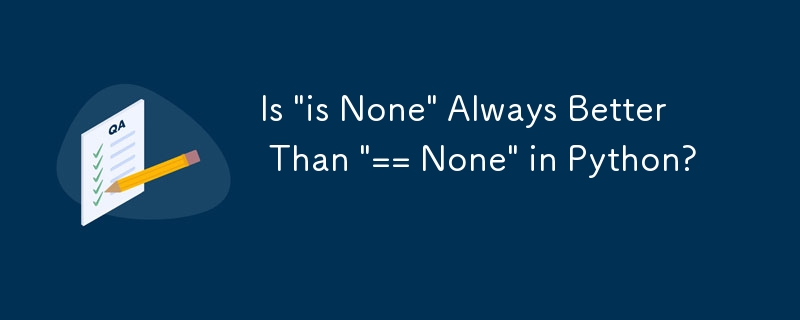

Determining the Distinction between "is None" and "== None"
In programming, the difference between "is None" and "== None" relates to value comparison and object identity. Understanding this distinction is essential for effective coding.
"is None" vs "== None": Defining the Difference
The "is" operator tests whether two objects are identical, referring to the same memory location. On the other hand, "==" compares the values of two objects, regardless of their locations in memory.
In the case of "None", it represents the absence of a value in Python. When using "== None", the comparison checks if the value of an object is "None". Conversely, "is None" verifies if the object itself is the None object.
Practical Usage and Considerations
Generally, it's recommended to use "is None" to check if an object is specifically the None object. This approach is more explicit and follows the Pythonic guideline of using "is" for identity comparisons.
However, in rare circumstances, classes may define custom comparison implementations. In such cases, the behavior of "== None" may vary depending on the class definition. Nonetheless, adhering to the use of "is None" for identity checks remains the preferred practice.
Conclusion
While the difference between "is None" and "== None" seems subtle, it's crucial to understand their respective purposes for accurate value comparisons and object identity testing. By employing "is None" consistently, developers can achieve precise code behaviors and avoid potential confusion arising from custom comparison implementations.
The above is the detailed content of Is \'is None\' Always Better Than \'== None\' in Python?. For more information, please follow other related articles on the PHP Chinese website!
 How to set font in css
How to set font in css
 The latest ranking of the top ten exchanges in the currency circle
The latest ranking of the top ten exchanges in the currency circle
 How many types of usb interfaces are there?
How many types of usb interfaces are there?
 Main purpose of file system
Main purpose of file system
 Windows checks port occupancy status
Windows checks port occupancy status
 Is it legal to buy and sell Bitcoin on Huobi.com?
Is it legal to buy and sell Bitcoin on Huobi.com?
 Mac shortcut key list
Mac shortcut key list
 What is an empty array in php
What is an empty array in php




